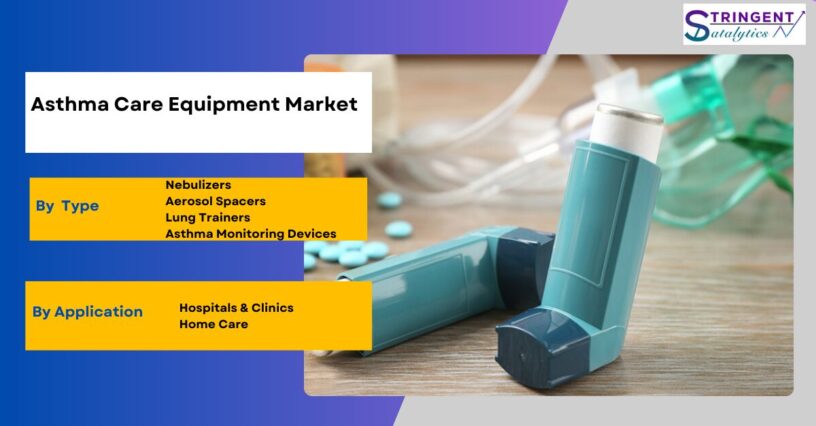The Asthma Care Equipment Market involves devices and technologies designed to help individuals manage and control asthma symptoms. Asthma is a chronic respiratory condition affecting millions worldwide, characterized by airway inflammation, breathing difficulties, and wheezing. The market includes a variety of devices such as inhalers, nebulizers, spirometers, peak flow meters, and oxygen concentrators that are essential for the prevention, diagnosis, and treatment of asthma.
Market Size and Growth
- Market Valuation: As of 2023, the global asthma care equipment market was valued at around USD 7 billion.
- Projected Growth: The market is expected to grow at a CAGR of 6-8% from 2024 to 2030, driven by increasing asthma prevalence, technological advancements in asthma management devices, and rising awareness of respiratory diseases.
- Key Growth Regions: North America and Europe currently dominate the market, while the Asia-Pacific region is expected to witness the fastest growth due to rising healthcare expenditure and improving medical infrastructure.
Key Factors Driving the Market
- Rising Asthma Prevalence:
- Asthma is a global public health issue, with approximately 300 million people affected worldwide. Increasing urbanization, pollution, and lifestyle changes are contributing to the rise in asthma cases.
- Pros: Higher prevalence of asthma necessitates better management and treatment solutions, boosting demand for asthma care equipment.
- Cons: High costs and limited access to advanced equipment in developing countries pose barriers to widespread adoption.
- Technological Advancements in Asthma Management:
- Innovations in inhaler technology, such as the development of smart inhalers that track usage and monitor symptoms, are driving market growth.
- Pros: Enhanced accuracy, portability, and connectivity of modern asthma care devices improve patient adherence and outcomes.
- Cons: Advanced devices can be expensive, limiting access for lower-income patients and healthcare systems.
- Increased Awareness of Respiratory Health:
- Government initiatives and public health campaigns focused on respiratory health are encouraging more frequent diagnosis and treatment of asthma.
- Pros: Increased awareness leads to earlier diagnosis and more proactive management, driving demand for diagnostic and therapeutic devices.
- Cons: In some regions, awareness remains low, particularly in rural or underserved areas.
- Growing Demand for Home Care Solutions:
- The rise of home healthcare and the shift from hospital-based care to home-based asthma management have spurred demand for portable and user-friendly devices.
- Pros: Home care solutions reduce hospital visits and empower patients to manage their condition independently.
- Cons: Ensuring proper usage and maintenance of devices in home settings can be challenging.
Market Segmentation
By Product Type
- Inhalers:
- The most commonly used asthma care equipment, including metered-dose inhalers (MDIs), dry powder inhalers (DPIs), and soft mist inhalers. Inhalers are critical for delivering medication directly to the lungs.
- Nebulizers:
- Devices that convert liquid medication into a mist, allowing patients to inhale it more easily. These are often used for children or individuals with severe asthma.
- Spirometers:
- Diagnostic tools used to measure lung function and assess the severity of asthma. Spirometry is commonly used for asthma diagnosis and monitoring.
- Peak Flow Meters:
- Portable devices used by patients to monitor their lung capacity and detect early signs of an asthma attack.
- Oxygen Concentrators:
- Devices used in severe cases of asthma where patients experience difficulty in breathing and require supplemental oxygen.
By End-User
- Hospitals and Clinics:
- The largest segment, as hospitals and clinics are the primary providers of diagnosis, treatment, and management of asthma.
- Home Care Settings:
- Increasingly popular due to the rise in home-based asthma management, particularly for chronic cases and elderly patients.
- Ambulatory Care Centers:
- Specialized centers providing asthma diagnosis and treatment, including spirometry tests and personalized care plans.
By Region
- North America: Dominates the market due to high asthma prevalence, strong healthcare infrastructure, and the adoption of advanced asthma care technologies.
- Europe: The second-largest market, with robust healthcare policies and significant investment in respiratory disease management.
- Asia-Pacific: Expected to be the fastest-growing region, driven by rising asthma cases, urban pollution, and increasing healthcare investments.
- Rest of the World: Growth is slower but steady, with rising awareness and access to medical technologies in emerging markets.
Market Challenges
- High Costs of Advanced Equipment:
- Smart inhalers and other technologically advanced devices can be expensive, limiting access for patients in low-income regions or those without adequate insurance.
- Limited Access to Healthcare in Developing Regions:
- Many developing countries face challenges in accessing asthma care equipment due to inadequate healthcare infrastructure and resources.
- Patient Adherence to Treatment:
- Proper usage of asthma care equipment, especially inhalers, can be difficult for some patients. Non-adherence to prescribed treatments can lead to poor disease management.
Market Trends
- Rising Adoption of Smart Inhalers:
- Smart inhalers that track usage patterns and deliver real-time data to healthcare providers are becoming more popular, as they improve patient outcomes and adherence.
- Focus on Portable and Wearable Devices:
- The market is seeing a trend toward smaller, more portable devices that allow patients to manage their asthma on the go, enhancing convenience and compliance.
- Integration with Telemedicine:
- The growth of telemedicine is enabling remote monitoring of asthma patients, with devices transmitting data directly to healthcare providers, allowing for better management and reduced hospital visits.
Key Players in the Market
- GlaxoSmithKline plc (GSK)
- Philips Healthcare
- AstraZeneca
- Becton, Dickinson and Company
- Teva Pharmaceutical Industries Ltd.
- Omron Healthcare
- Novartis AG
- ResMed Inc.
- 3M Healthcare
- Merck & Co., Inc.
These companies are investing heavily in research and development to improve asthma care technologies and expand their product portfolios to meet growing demand.
Future Outlook
The asthma care equipment market is poised for steady growth due to increasing asthma prevalence, technological advancements, and growing demand for home-based care solutions. While challenges such as high costs and limited access in developing regions remain, the market’s future looks promising, with continued innovation in smart and portable devices, as well as the integration of digital health technologies to enhance patient management and outcomes.
Click Here, To Get Free Sample Report https://stringentdatalytics.com/sample-request/asthma-care-equipment-market/15993/
Market Segmentations:
Global Asthma Care Equipment Market: By Company
Respiri
Spirosure
Volansys Technologies
Vitalograph
Health Care Originals
Microlife
OMRON Healthcare
ISonea
Quvium
Adherium
National Jewish Health
Aerogen
Pari
Global Asthma Care Equipment Market: By Type
Nebulizers
Aerosol Spacers
Lung Trainers
Asthma Monitoring Devices
Global Asthma Care Equipment Market: By Application
Hospitals & Clinics
Home Care
Global Asthma Care Equipment Market: Regional Analysis
The regional analysis of the global Asthma Care Equipment market provides insights into the market’s performance across different regions of the world. The analysis is based on recent and future trends and includes market forecast for the prediction period. The countries covered in the regional analysis of the Asthma Care Equipment market report are as follows:
North America: The North America region includes the U.S., Canada, and Mexico. The U.S. is the largest market for Cold-chain Pharma in this region, followed by Canada and Mexico. The market growth in this region is primarily driven by the presence of key market players and the increasing demand for the product.
Europe: The Europe region includes Germany, France, U.K., Russia, Italy, Spain, Turkey, Netherlands, Switzerland, Belgium, and Rest of Europe. Germany is the largest market for Cold-chain Pharma in this region, followed by the U.K. and France. The market growth in this region is driven by the increasing demand for the product in the automotive and aerospace sectors.
Asia-Pacific: The Asia-Pacific region includes Singapore, Malaysia, Australia, Thailand, Indonesia, Philippines, China, Japan, India, South Korea, and Rest of Asia-Pacific. China is the largest market for Cold-chain Pharma in this region, followed by Japan and India. The market growth in this region is driven by the increasing adoption of the product in various end-use industries, such as automotive, aerospace, and construction.
Middle East and Africa: The Middle East and Africa region includes Saudi Arabia, U.A.E, South Africa, Egypt, Israel, and Rest of Middle East and Africa. The market growth in this region is driven by the increasing demand for the product in the aerospace and defense sectors.
South America: The South America region includes Argentina, Brazil, and Rest of South America. Brazil is the largest market for Cold-chain Pharma in this region, followed by Argentina. The market growth in this region is primarily driven by the increasing demand for the product in the automotive sector.
Click Here, To Buy Premium Report https://stringentdatalytics.com/purchase/asthma-care-equipment-market/15993/?license=single
Reasons to Purchase this Report
- Market segmentation based on qualitative and quantitative analysis, taking into account both economic and non-economic aspects.
- Data on market value (in US dollars) for each section and sub-segment
- Identifies the area and market segment anticipated to experience the quickest growth and hold the majority of the market.
- Analysis by geography showcasing product/service usage in the region and highlighting the market dynamics affecting each region.
- A competitive landscape that takes into account recent service/product launches, collaborations, company expansions, and acquisitions by the companies profiled, as well as the market share of the leading players.
- Comprehensive company profiles for the top players in the industry, including business overviews, corporate insights, product benchmarking, and SWOT analyses
- The industry’s future market forecast in light of recent changes, including growth possibilities, drivers of growth, and obstacles present in both developing and emerging economies.
- Comprises a thorough examination of the market from a number of angles using Porter’s Five Forces analysis.
- Offers market knowledge across the Value Chain
- The current market dynamics scenario and future market expansion prospects
- Post-sales analyst assistance for six months
About Stringent Datalytics
Stringent Datalytics offers both custom and syndicated market research reports. Custom market research reports are tailored to a specific client’s needs and requirements. These reports provide unique insights into a particular industry or market segment and can help businesses make informed decisions about their strategies and operations.
Syndicated market research reports, on the other hand, are pre-existing reports that are available for purchase by multiple clients. These reports are often produced on a regular basis, such as annually or quarterly, and cover a broad range of industries and market segments. Syndicated reports provide clients with insights into industry trends, market sizes, and competitive landscapes. By offering both custom and syndicated reports, Stringent Datalytics can provide clients with a range of market research solutions that can be customized to their specific needs.
Contact Us
Stringent Datalytics
Contact No- +1 346 666 6655
Email Id- sales@stringentdatalytics.com
Web- https://stringentdatalytics.com/




Leave a Reply